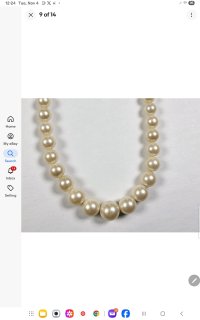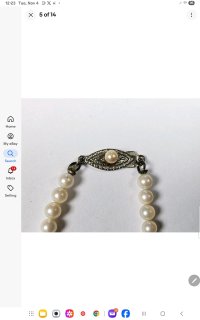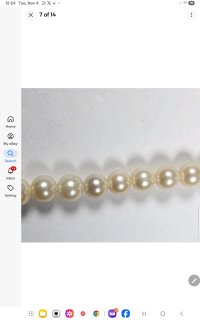Are these Akoya pearls? They looked right to me, but I am not an expert. I sold them on Ebay and the buyer is stating that they are glass. Did I screw up? Thank you for your expertise!
You are using an out of date browser. It may not display this or other websites correctly.
You should upgrade or use an alternative browser.
You should upgrade or use an alternative browser.
Pearl identification help
- Thread starter mely
- Start date
Pearl Dreams
Pearl Enthusiast
Sorry, they are indeed glass.
You may like to also see this thread, to learn more about what fake pearls can look like. Some are very good imitations.
You may like to also see this thread, to learn more about what fake pearls can look like. Some are very good imitations.
Some of us want a place to share photos and stories of various man-made pearl-lookalikes, so let's put them here. This can be helpful for comparison and educational purposes, examples of jewelry, vintage or new, which are not cultured or natural pearls. I'll be taking some photos soon!
- pattye
- Replies: 215
- Forum: Identify my Pearls!
Pearl Dreams
Pearl Enthusiast
vampyrika
Pearl Enthusiast
Can I ask what stood out to you on this particular strand that helped you identify them as glass?Sorry, they are indeed glass.
You may like to also see this thread, to learn more about what fake pearls can look like. Some are very good imitations.
Some of us want a place to share photos and stories of various man-made pearl-lookalikes, so let's put them here. This can be helpful for comparison and educational purposes, examples of jewelry, vintage or new, which are not cultured or natural pearls. I'll be taking some photos soon!
- pattye
- Replies: 215
- Forum: Identify my Pearls!
Thank you for sharing the older thread as well, lots of useful information and examples!
Pearl Dreams
Pearl Enthusiast
Do you see that coarse texture that is visible when the pearls are so enlarged? That is pretty much what you'd see looking at imitation pearls under a 10x loupe. Real pearl nacre looks smooth under 10x magnification.
Also the combination of all these traits:
• All the pearls look exactly the same-- same size (except for the one center pearl), color, luster. In a real pearl necklace you'd see more variation, including varying overtones in more lustrous pearls. Real pearls in a necklace are not all going to be the same size-- they are made by living mollusks, so they don't come out a calibrated size. Typically a necklace would have pearls ranging in size within 0.5mm (e.g. 6.5-7.0mm) And graduated strands don't just have one larger center pearl.
• The lack of any blemishes typically found in real pearls. Even a very good strand will have some minor pinpricks.
• They are not knotted between pearls (but this can be true of real pearls-- however, usually at least the end few pearls will be knotted.)
• Cheaply finished with the bead tips instead of gimp (but real pearls are sometimes finished that way, so it's not definitive).
• Clasp looks like base metal. Edited to add: However, even fake strands can have silver clasps, and I even have a few Majorica imitations pearl pieces with solid 18K gold clasps.
All of it put together screams "fake."
Also the combination of all these traits:
• All the pearls look exactly the same-- same size (except for the one center pearl), color, luster. In a real pearl necklace you'd see more variation, including varying overtones in more lustrous pearls. Real pearls in a necklace are not all going to be the same size-- they are made by living mollusks, so they don't come out a calibrated size. Typically a necklace would have pearls ranging in size within 0.5mm (e.g. 6.5-7.0mm) And graduated strands don't just have one larger center pearl.
• The lack of any blemishes typically found in real pearls. Even a very good strand will have some minor pinpricks.
• They are not knotted between pearls (but this can be true of real pearls-- however, usually at least the end few pearls will be knotted.)
• Cheaply finished with the bead tips instead of gimp (but real pearls are sometimes finished that way, so it's not definitive).
• Clasp looks like base metal. Edited to add: However, even fake strands can have silver clasps, and I even have a few Majorica imitations pearl pieces with solid 18K gold clasps.
All of it put together screams "fake."
Last edited:
vampyrika
Pearl Enthusiast
That makes complete sense! Thank you!Do you see that coarse texture that is visible when the pearls are so enlarged? That is pretty much what you'd see looking at imitation pearls under a 10x loupe. Real pearl nacre looks smooth under 10x magnification.
Also the combination of all these traits:
• All the pearls look exactly the same-- same size (except for the one center pearl), color, luster. In a real pearl necklace you'd see more variation, including varying overtones in more lustrous pearls. Real pearls in a necklace are not all going to be the same size-- they are made by living mollusks, so they don't come out a calibrated size. Typically a necklace would have pearls ranging in size within 0.5mm (e.g. 6.5-7.0mm) And graduated strands don't just have one larger center pearl.
• The lack of any blemishes typically found in real pearls. Even a very good strand will have some minor pinpricks.
• They are not knotted between pearls (but this can be true of real pearls-- however, usually at least the end few pearls will be knotted.)
• Cheaply finished with the bead tips instead of gimp (but real pearls are sometimes finished that way, so it's not definitive).
• Clasp looks like base metal.
All of it put together screams "fake."
I'm getting better at differentiating real vs. fake pearls in person, but it's a little harder for me to do with just photos. I really appreciate you taking the time to include all the information you did. Thank you again!
Pearl Dreams
Pearl Enthusiast
Here are a few simple tests to tell whether pearls are real or fake, that may help the OP for the next time:
1. Rubbing test (also called "tooth test" but please don't rub pearls on your teeth. Teeth are harder than pearls and can scratch them.
Rub 2 of the pearls together (don't rub hard). Real nacre feels gritty. Fake pearls slide more smoothy against each other.
If they are grimy this can make them stick a bit, so clean them first with a damp microfiber cloth.
2. Temperature test:
Real pearls are cooler than fake glass or plastic pearls. To test, you will need other pearls to compare with, pearls that you know are real or that you know are fake. Place the unknown pearls and the known pearls in the same temperature environment for half an hour or so before testing. Then hold them to your lips briefly, and compare what you feel. Why this works: lips are very sensitive to temperature.
3. Loupe test:
Look at the pearls under a loupe. As stated in previous post, real pearl nacre looks smooth at 10x magnification; fake pearls look more coarse.
I encourage anyone who buys or sells jewelry to purchase a loupe. They are not costly. I keep one in my purse.
1. Rubbing test (also called "tooth test" but please don't rub pearls on your teeth. Teeth are harder than pearls and can scratch them.
Rub 2 of the pearls together (don't rub hard). Real nacre feels gritty. Fake pearls slide more smoothy against each other.
If they are grimy this can make them stick a bit, so clean them first with a damp microfiber cloth.
2. Temperature test:
Real pearls are cooler than fake glass or plastic pearls. To test, you will need other pearls to compare with, pearls that you know are real or that you know are fake. Place the unknown pearls and the known pearls in the same temperature environment for half an hour or so before testing. Then hold them to your lips briefly, and compare what you feel. Why this works: lips are very sensitive to temperature.
3. Loupe test:
Look at the pearls under a loupe. As stated in previous post, real pearl nacre looks smooth at 10x magnification; fake pearls look more coarse.
I encourage anyone who buys or sells jewelry to purchase a loupe. They are not costly. I keep one in my purse.
Last edited:
Thank you so much! I took the Pearl Course a few months ago. The course was amazing and I learned a ton! This one slipped by me though. The hardware is 925 silver and I purchased through a reputable seller in Japan. I should have looked closer and spent more time before listing on Ebay. I think I have learned my lesson. I appreciate you taking the time to explain. I appreciate you and this amazing group!
Pearl Dreams
Pearl Enthusiast
When you get it back, do the tests I suggested on it.
Pearl Dreams
Pearl Enthusiast
I will give you one more test but it is destructive-- it won't harm real pearls but it will take the coating right off fake ones.
Saturate a cotton ball with acetone or nail polish remover, and rub the pearl with it. Like I said, it will dissolve fake pearl coatings, ruining them, but won't damage real pearls.
(Then wipe the pearl with water to remove any acetone residue.)
Saturate a cotton ball with acetone or nail polish remover, and rub the pearl with it. Like I said, it will dissolve fake pearl coatings, ruining them, but won't damage real pearls.
(Then wipe the pearl with water to remove any acetone residue.)
Mely... One thing that works really well, in person is to look at drill holes of pearls. I have had dirty faux pearls be gritty. So I always look at drill holes. In fact, I put one in my restringing pile without looking at drill holes, just checked grit.... but when I pulled it out to restring...I noticed coating loss that I missed the first time.... then I looked at drill holes!!! There was a flat mold mark around the drill holes. I simply moved it over to the "harvest clasp" pile. But I need to make sure by at least 3 means (Grit, drill holes & at least 1 other way...such as nacre and variations) before I tell other people that these are cultured pearls. The only time I did NOT have a triple check...a friend ask me about his pearls and I didn't have a loupe... I gave him a quick: real, but took them home to do the triple check....the drill holes had paint build up = faux. I had to contact him with the disappointment. Great lesson for me...now I tell people that I need to triple check before I give my assessment so people don't get disappointed.
Pearl Dreams
Pearl Enthusiast
Grittiness is indeed one test that sometimes fails because it varies between pearls-- even between fake pearls-- and the observation of a feeling of grittiness is somewhat subjective. And yes, grime on the pearl can make it feel not-smooth.
Also, real pearls may have been coated with something to make them look more lustrous (note, this is not done with good pearls), so they may test as fake on grittiness test. In addition, there may be imitation coatings that incorporate gritty substances (I have not personally felt this but I can imagine some may be out there.)
Also, real pearls may have been coated with something to make them look more lustrous (note, this is not done with good pearls), so they may test as fake on grittiness test. In addition, there may be imitation coatings that incorporate gritty substances (I have not personally felt this but I can imagine some may be out there.)
Similar threads
- Replies
- 8
- Views
- 498
- Replies
- 10
- Views
- 776
- Replies
- 5
- Views
- 431
- Replies
- 5
- Views
- 723






